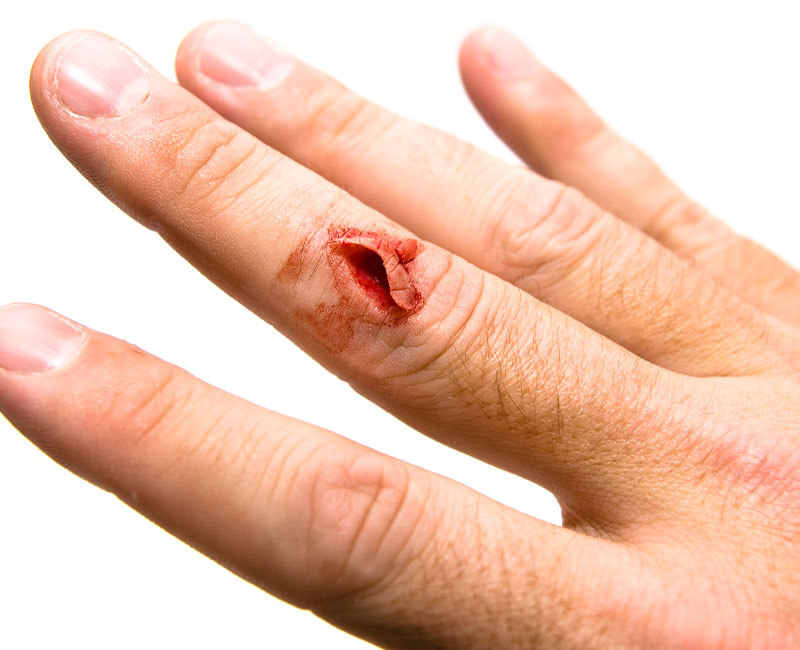Lacerations can be minor, like nicks from shaving or paper cuts. But when they’re larger or deeper, they can be much more serious. Recognizing when a laceration is self-treatable and when they need professional medical care can make a big difference for you or someone you care for.
Advertisement
Cleveland Clinic is a non-profit academic medical center. Advertising on our site helps support our mission. We do not endorse non-Cleveland Clinic products or services. Policy

Lacerations are traumatic injuries that involve rips or tears in your body’s tissues. While skin lacerations are the most common, these wounds can happen to tissues inside your body, too. They can even happen without the laceration affecting the outside of your body.
Advertisement
Cleveland Clinic is a non-profit academic medical center. Advertising on our site helps support our mission. We do not endorse non-Cleveland Clinic products or services. Policy
Lacerations are incredibly common. They can be as minor as an everyday paper cut or nick while shaving or as severe as life-threatening wounds that need emergency medical care.
Experts often classify lacerations in one of two ways:
Minor lacerations are easy to treat yourself. But it’s important to know when these wounds are more serious and need professional medical care.
The main symptoms of a laceration are pain and bleeding. If the laceration affects or passes through our skin, it will cause a visible opening in your skin’s surface. But if the laceration is internal only, like a torn muscle, you may have different symptoms, like bruising or swelling.
The type or location of tissue affected can change or intensify the symptoms that you experience. For example, your face or scalp will typically bleed very heavily because they’re packed full of capillaries. And lacerations to blood vessels, like veins and arteries, also bleed heavily.
And some symptoms are very specific to certain types of lacerations. For example, a nerve laceration can cause tingling, numbness, weakness or paralysis, or nerve pain.
Advertisement
Lacerations can happen when something causes ripping or tearing of tissues in your body. Some of the most common causes include, but aren’t limited to, the following:
Lacerations usually involve one or more of the following:
Many lacerations involve more than one of the above, especially when the laceration is more severe. For example, lacerations can be very large when a tear happens with a lot of force, making the wound bigger. One specific example of this would be ring avulsions.
So, if you have a laceration that might involve multiple types of damage or injury, your best bet is to seek professional medical care. Erring on the side of caution can make a big difference in the long run.
Some of the most common complications of lacerations include:
The complications you might experience can be very specific to your case, health history and other factors. Your healthcare provider is the best person to tell you about the possible complications.
Surface lacerations are easier to diagnose because a healthcare provider can see them and feel for nearby tissue changes. That makes a physical exam one of the most important parts of diagnosing lacerations.
Advertisement
When lacerations happen inside your body without a visible surface wound, a physical exam can still help with diagnosis. But it also usually takes tests like imaging scans, especially CT scans and magnetic resonance imaging (MRI).
You might need other tests depending on how your laceration happened, your health history and other factors. Your healthcare provider can tell you about possible tests and why they might help.
Laceration treatments range from simple home remedies to professional medical care. The type of treatment mainly depends on the laceration’s size, depth, location and cause.
Minor lacerations are treatable with simple cleaning and bandaging. But for more serious lacerations, the following treatments are possible:
Advertisement
You might receive other treatments, too, depending on your health history and other factors. Your healthcare provider can tell you more about the treatment options for your case.
Lacerations are common, and most of the smaller and shallower ones heal quickly and easily. Even larger, deeper lacerations typically respond well if they get proper treatment right away.
But when lacerations don’t get proper treatment fast enough, it can take them longer to heal. This increases your risk of complications like infections and scarring. Your health history and any chronic conditions you have can also factor in. That means your healthcare provider is the best source of information about what you should expect with your case.
Lacerations usually happen unpredictably, so there’s no way to prevent them entirely. But there are several things you can do to reduce your risk of lacerations from common laceration-causing events:
Advertisement
You can self-treat minor lacerations. These injuries are minor when they’re:
When a laceration doesn’t meet any of these criteria, it needs professional medical care. That usually means care in a doctor’s office or an urgent care clinic-type setting.
But lacerations need immediate medical attention at an emergency room or hospital when they:
Some laceration-related questions you can ask your healthcare provider include:
Maybe you nicked yourself shaving, or your grip slipped while chopping veggies during meal prep. Both are common ways for lacerations to happen. Knowing how to manage these injuries is easy when they’re small, but it’s important to know when they need professional care. You might feel tempted to downplay or ignore it, but when in doubt, seek medical care. Timely treatment can make your recovery easier and faster, and help you avoid long-term complications or issues.
Need care fast? Cleveland Clinic’s Express Care and Urgent Care locations treat everything from sprains to sinus infections — no appointment needed.

Last reviewed on 06/12/2025.
Learn more about the Health Library and our editorial process.